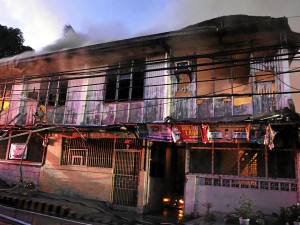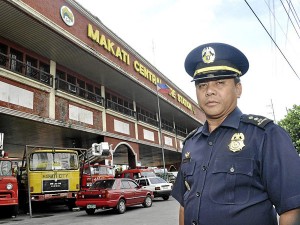
On April 19, 2011, deep in the heart of a bone-dry summer, the Laperal Compound in Guadalupe Viejo, Makati City went up in flames. The fire spread quickly and mercilessly, jumping from one fragile shanty to another in the compound which housed a large population of informal settlers. By the end of the day, some 900 dwellings would be reduced to ash and the area would be declared a danger zone, a territory so risky that the former dwellers were no longer allowed to return.
Perhaps the most unusual observation about the Laperal Compound fire is just how rare it is. In Makati, with its forest of skyscrapers, thickets of residential areas and business centers, the place is both temporary and permanent home to a lot of people worrying about different things.
Fire is not one of them, thanks to the dedicated force of firefighters, among them Senior Insp. Eduardo F. Visbal. Visbal is chief of the Makati Bureau of Fire Protection’s Fire Safety Enforcement Unit (FSEU) that makes sure buildings are built in accordance with the fire code.
This requires, for example, that buildings have automatic fire suppression systems such as sprinklers, and portable ones like fire extinguishers.
“In Makati, fire isn’t common because all the buildings have fire suppression systems,” Visbal explains. “Fire is more common in depressed areas, like the Laperal compound. The fire there was the last – and only – big fire we dealt with this year.”
Visbal is proud to say that Makati rarely has fires because of its strict obedience to the fire code. For 2011, for example, he says the fire protection unit has responded to less than 20 fire incidents. The city also has enough personnel and equipment. Each of the city’s 16 sub-stations has a dedicated fire truck. The trucks are manned by almost 300 personnel working in three shifts, with seven to eight people per shift.
Visbal gives several pointers about keeping safe when it comes to fires:

The three most common kinds of fires involve light materials, gas leaks and unattended appliances. Structures made of plywood and other kinds of light wood are prone to catching fire. Many shanties in informal settlements often catch fire because they are made of light materials that can ignite when two wires are touching each other, or catch fire because someone fell asleep without putting out a cigarette. Fires of this type can spread quickly, especially if it’s summer and the air is dry. This kind of fire can be put out by water.
A gas leak fire happens when someone lights a cigarette or candle while someone else is using gas for cooking. Gas is invisible though you can smell it. This occurs most commonly with LPG tanks that have been left open or are leaking because of a hole in the hose. Foam and other chemicals are used to put out this type of fire.
Unattended electrical appliances are the third most common cause of fire. People sometimes forget to switch off flat irons or electric stoves, especially when they’re tired after doing chores or are distracted. When a spark reaches flammable material like clothes and curtains, the fire starts to spread. Water is also used to put out this kind of fire.
It is crucial to have designated exits in one’s home in case of fire. The front door is what you would consider the primary exit. Plan to have secondary exits as well.
It is also important to put out the fire first using portable suppression systems. Educate the househelp on how to use fire extinguishers. When talking to the help, remind them to switch off the stove after cooking, and the iron after pressing clothes. Avoid smoking inside the house.
Don’t jump out of a building in case of fire. Even if the window isn’t very high, you risk breaking some bones or worse, hitting the ground head first. Find ladders and stairs and use them to exit buildings safely.
Make sure your offices and business centers have building plans approved by the FSEU that will indicate what automatic fire suppression systems are needed.
Be aware that sprinklers don’t go on at the merest hint of a fire, nor can they be triggered by smoke. The fire has to reach a certain magnitude so as to trigger the sprinkler, and only in the area where the fire is. As the fire spreads, it will trigger the other sprinklers one at a time.
Fire drills are a useful practice. Offices should have fire drills twice a year.
Unplug. In offices, train employees to switch off all appliances when they leave. One common cause of fires in office buildings is the water dispenser that overheats when left plugged in overnight. This is also true for ceiling fans and electric fans.
Keep fire extinguishers handy. Under the law, offices are required to have a fire extinguisher for every 50 square meters of space. But if the office has combustible material – say a warehouse full of paper, plastic or certain chemicals –additional fire extinguishers are needed. The contents of a fire extinguisher don’t expire. The most common reason to replace one is because you’ve used it up. Occasionally though, a fire extinguisher loses pressure and needs to be replaced.
Visbal reminds people to be vigilant and call in reports of fire promptly: “We can only respond as quickly as we are informed of a fire,” he says.
It is important that people know what to do in the event of a fire. The most important thing to remember?
“Have presence of mind,” says Visbal. “Don’t lose hope.” •
In case of fire, call the Bureau of Fire Protection’s National Capital Region hotlines: 729-5166, 723-1642 and 117.












































